Research on b Value Estimation Based on Apparent Amplitude-Frequency Distribution in Rock Acoustic Emission Tests
Abstract
:1. Introduction
2. Optimal b Value Estimation Procedure Based on Apparent Amplitude-Frequency Distribution
2.1. Synthetic Catalogues of Rock AE Apparent Amplitude
2.2. Determination of Optimal Estimation Method for Ac and A0
2.3. The Optimal b Value Estimation Procedure through Apparent Amplitude-Frequency Distribution for Rock AE Tests
3. Application of MFBG in b Value Estimation of Rock AE Test
4. Conclusions
Author Contributions
Funding
Institutional Review Board Statement
Informed Consent Statement
Data Availability Statement
Conflicts of Interest
References
- Gutenberg, B.; Richter, C. Frequency of earthquakes in California. Bull. Seism. Soc. Am. 1944, 34, 185–188. [Google Scholar] [CrossRef]
- Kagan, Y.Y. Seismic moment-frequency relation for shallow earthquakes: Regional comparison. J. Geophys. Res. Earth Surf. 1997, 102, 2835–2852. [Google Scholar] [CrossRef]
- Triep, E.; Sykes, L.R. Frequency of occurrence of moderate to great earthquakes in intracontinental regions: Implications for changes in stress, earthquake prediction, and hazard assessment. J. Geophys. Res. Earth Surf. 1997, 102, 9923–9948. [Google Scholar] [CrossRef]
- Main, I.G.; Li, L.; McCloskey, J.; Naylor, M. Effect of the Sumatran mega-earthquake on the global magnitude cut-off and event rate. Nat. Geosci. 2008, 1, 142. [Google Scholar] [CrossRef]
- Jordan, T.H.; Chen, Y.-T.; Gasparini, P.; Madariaga, R.; Main, I.; Marzocchi, W.; Papadopoulos, G.; Sobolev, G.; Yamaoka, K.; Zschau, J. Operational earthquake forecasting: State of Knowledge and Guidelines for Utilization. Ann. Geophys. 2011, 54, 361–391. [Google Scholar]
- Liu, X.; Liu, Z.; Li, X.; Gong, F.; Du, K. Experimental study on the effect of strain rate on rock acoustic emission characteristics. Int. J. Rock Mech. Min. Sci. 2020, 133, 104420. [Google Scholar] [CrossRef]
- Liu, X.; Li, X.; Hong, L.; Yin, T.; Rao, M. Acoustic emission characteristics of rock under impact loading. J. Cent. South Univ. 2015, 22, 3571–3577. [Google Scholar] [CrossRef]
- Amorese, D. Applying a change-point detection method on frequency-magnitude distributions. Bull. Seism. Soc. Am. 2007, 97, 1742–1749. [Google Scholar] [CrossRef]
- Mogi, K. Study of the elastic shocks caused by the fracture of heterogeneous materials and its relations to earthquake phenomena. Bull. Earthq. Res. Inst. 1962, 40, 125–173. [Google Scholar]
- Main, I.; Sammonds, P.; Meredith, P. Application of a modified Griffith criterion to the evolution of fractal damage during compressional rock failure. Geophys. J. Int. 1993, 115, 367–380. [Google Scholar] [CrossRef]
- Mori, J.; Abercrombie, R. Depth dependence of earthquake frequency-magnitude distributions in California: Implications for rupture initiation. J. Geophys. Res. 1997, 102, 15081–15090. [Google Scholar] [CrossRef]
- Wiemer, S.; Wyss, M. Mapping the frequency-magnitude distribution in asperities: An improved technique to calculate recurrence times? J. Geophys. Res. 1997, 102, 15115–15128. [Google Scholar] [CrossRef]
- Schorlemmer, D.; Wiemer, S.; Wyss, M. Variations in earthquake size distribution across different stress regimes. Nature 2005, 437, 539–542. [Google Scholar] [CrossRef]
- Scholz, C. On the stress dependence of the earthquake b value. Geophys. Res. Lett. 2015, 42, 1399–1402. [Google Scholar] [CrossRef]
- Carpinteri, A.; Lacidogna, G.; Puzzi, S. From criticality to final collapse: Evolution of the ‘‘b-value” from 1.5 to 1.0. Chaos Solitons Fractals 2009, 41, 843–853. [Google Scholar] [CrossRef]
- D’Angela, D.; Ercolino, M.; Bellini, C.; Cocco, V.D.; Iacoviello, F. Characterisation of the damaging micromechanisms in a pearlitic ductile cast iron and damage assessment by acoustic emission testing. Fatigue Fract. Eng. Mater. Struct. 2020, 43, 1038–1050. [Google Scholar] [CrossRef]
- Xu, J.; Fu, Z.; Lacidogna, G.; Carpinteri, A. Micro-cracking monitoring and fracture evaluation for crumb rubber concrete based on acoustic emission techniques. Struct. Health Monit. 2018, 17, 946–958. [Google Scholar] [CrossRef]
- Colombo, I.S.; Main, I.G.; Forde, M.C. Assessing Damage of Reinforced Concrete Beam Using “b-value” Analysis of Acoustic Emission Signals. J. Mater. Civ. Eng. 2003, 15, 280–286. [Google Scholar] [CrossRef]
- Mignan, A.; Woessner, J. Estimating the magnitude of completeness for earthquake catalogs. Community Online Resour. Stat. Seism. Anal. 2012, 1–45. [Google Scholar] [CrossRef]
- Kijko, A.; Smit, A. Estimation of the frequency-magnitude Gutenberg-Richter b-value without level of completeness. Seismol. Res. Lett. 2017, 88, 311–318. [Google Scholar] [CrossRef]
- Ross, Z.; Trugman, D.; Hauksson, E.; Shearer, P. Searching for hidden earthquakes in Southern California. Science 2019, 364, 767–771. [Google Scholar] [CrossRef]
- Rydelek, P.; Sacks, I. Testing the completeness of earthquake catalogs and the hypothesis of self-similarity. Nature 1989, 337, 251–253. [Google Scholar] [CrossRef]
- Wiemer, S.; Wyss, M. Minimum magnitude of completeness in earthquake catalogs: Examples from Alaska, the western United States, and Japan. Bull. Seism. Soc. Am. 2000, 90, 859–869. [Google Scholar] [CrossRef]
- Cao, A.; Gao, S. Temporal variation of seismic b-values beneath northeastern Japan island arc. Geophys. Res. Lett. 2002, 29, 1334. [Google Scholar] [CrossRef]
- Liu, X.; Han, M.; He, W.; Li, X.; Chen, D. A new b value estimation method in rock acoustic emission testing. J. Geophys. Res. 2020, 125, e2020JB019658. [Google Scholar] [CrossRef]
- Han, Q.; Wang, L.; Xu, J.; Carpinteri, A.; Lacidogna, G. A robust method to estimate the b-value of the magnitude-frequency distribution of earthquakes. Chaos Solit. Fractals 2015, 81, 103–110. [Google Scholar] [CrossRef]
- Marzocchi, W.; Spassiani, I.; Stallone, A.; Taroni, M. Erratum to: How to be fooled searching for significant variations of the b-value. Geophys. J. Int. 2020, 221, 351. [Google Scholar] [CrossRef]
- Dong, L.; Chen, Y.; Sun, D.; Zhang, Y. Implications for rock instability precursors and principal stress direction from rock acoustic experiments. Int. J. Min. Sci. Technol. 2021, 31, 789–798. [Google Scholar] [CrossRef]
- Lei, X.; Kusunose, K.; Nishizawa, O.; Cho, A.; Satoh, T. On the spatio-temporal distribution of acoustic emissions in two granitic rocks under triaxial compression: The role of pre-existing cracks. J. Geophys. Res. 2000, 27, 1997–2000. [Google Scholar] [CrossRef]
- Lei, X.; Kusunose, K.; Rao, M.; Nishizawa, O.; Satoh, T. Quasi-static fault growth and cracking in homogeneous brittle rock under triaxial compression using acoustic emission monitoring. J. Geophys. Res. Solid Earth 2000, 105, 6127–6139. [Google Scholar] [CrossRef]
- Thompson, B.; Young, R.; Lockner, D. Fracture in Westerly granite under AE feedback and constant strain rate loading: Nucleation, quasi-static propagation, and the transition to unstable fracture propagation. Pure Appl. Geophys. 2006, 163, 995–1019. [Google Scholar] [CrossRef]
- Mogi, K. Magnitude-frequency relationship for elastic shocks accompanying fractures of various materials and some related problems in earthquakes. Bull. Earthq. Res. Inst. 1962, 40, 831–853. [Google Scholar]
- Scholz, C. The frequency-magnitude relation of microfracturing in rock and its relation to earthquakes. Bull. Seismol. Soc. Am. 1968, 58, 399–415. [Google Scholar] [CrossRef]
- Lockner, D. The role of acoustic emission in the study of rock fracture. Int. J. Rock Mech. Min. Sci. Geomech. Abstr. 1993, 30, 883–899. [Google Scholar] [CrossRef]
- Lei, X. How do asperities fracture? An experimental study of unbroken asperities. Earth Planet Sci. Lett. 2003, 213, 347–359. [Google Scholar] [CrossRef]
- Goebel, T.; Candela, T.; Sammis, C.; Becker, T.; Dresen, G.; Schorlemmer, D. Seismic event distributions and off-fault damage during frictional sliding of saw-cut surfaces with pre-defined roughness. Geophys. J. Int. 2014, 196, 612–625. [Google Scholar] [CrossRef]
- Vorobieva, I.; Shebalin, P.; Narteau, C. Break of slope in earthquake-size distribution and creep rate along the San Andreas fault system. Geophys. Res. Lett. 2016, 43, 6869–6875. [Google Scholar] [CrossRef]
- Dong, L.; Hu, Q.; Tong, X.; Liu, Y. Velocity-Free MS/AE Source Location Method for Three-Dimensional Hole-Containing Structures. Engineering 2020, 6, 827–834. [Google Scholar] [CrossRef]
- Dong, L.; Tong, X.; Ma, J. Quantitative Investigation of Tomographic Effects in Abnormal Regions of Complex Structures. Engineering 2021, 7, 1011–1022. [Google Scholar] [CrossRef]
- Dong, L.; Tong, X.; Hu, Q.; Tao, Q. Empty region identification method and experimental verification for the two-dimensional complex structure. Int. J. Rock Mech. Min. Sci. 2021, 147, 104885. [Google Scholar] [CrossRef]
- Dong, L.; Zhang, L.; Liu, H.; Du, K.; Liu, X. Acoustic Emission b Value Characteristics of Granite under True Triaxial Stress. Mathematics 2022, 10, 451. [Google Scholar] [CrossRef]
- Dong, L.; Luo, Q. Investigations and new insights on earthquake mechanics from fault slip experiments. Earth Sci. Rev. 2022, 228, 104019. [Google Scholar] [CrossRef]
- Main, I.; Meredith, P.; Jones, C. A reinterpretation of the precursory seismic b-value anomaly from fracture mechanics. J. Geophys. Res. 1989, 96, 131–138. [Google Scholar] [CrossRef]
- Lockner, D.; Byerlee, J.; Kuksenko, V.; Ponomarev, A.; Sidorin, A. Quasi-static fault growth and shear fracture energy in granite. Nature 1991, 350, 39–42. [Google Scholar] [CrossRef]
- Sammonds, P.; Meredith, P.; Main, I. Role of pore fluids in the generation of seismic precursors to shear fracture. Nature 1992, 359, 228–230. [Google Scholar] [CrossRef]
- Goebel, T.; Schorlemmer, D.; Becker, T.; Dresen, G.; Sammis, C. Acoustic emissions document stress changes over many seismic cycles in stick-slip experiments. Geophys. Res. Lett. 2013, 40, 2049–2054. [Google Scholar] [CrossRef]
- Lennartz-Sassinek, S.; Main, I.; Zaiser, M.; Graham, C. Acceleration and localization of subcritical crack growth in a natural composite material. Phys. Rev. E 2014, 90, 052401. [Google Scholar] [CrossRef]
- Kwiatek, G.; Goebel, T.; Dresen, G. Seismic moment tensor and b value variations over successive seismic cycles in laboratory stick-slip experiments. Geophys. Res. Lett. 2014, 41, 5838–5846. [Google Scholar] [CrossRef]
- Chen, D.; Liu, X.; He, W.; Xia, C.; Gong, F.; Li, X.; Cao, X. Effect of attenuation on amplitude distribution and b value in rock acoustic emission tests. Geophys. J. Int. 2021, 229, 933–947. [Google Scholar] [CrossRef]
- Amorese, D.; Grasso, J.; Rydelek, P. On varying b values with depth: Results from computer-intensive tests for Southern California. Geophys. J. Int. 2010, 180, 347–360. [Google Scholar] [CrossRef]
- Shi, Y.; Blot, B. The standard error of the magnitude-frequency b value. Bull. Seismol. Soc. Am. 1982, 72, 1677–1687. [Google Scholar] [CrossRef]
- Clauset, A.; Shalizi, C.; Newman, M. Power-law distributions in empirical data. Siam. Rev. 2007, 51, 661–703. [Google Scholar] [CrossRef]
- Greenhough, J.; Main, I. A Poisson model for earthquake frequency uncertainties in seismic hazard analysis. Geophys. Res. Lett. 2008, 35, L19313. [Google Scholar] [CrossRef] [Green Version]
- Aki, K. Maximum likelihood estimate of b in the formula logN = a − bM and its confidence limits. Bull. Earthq. Res. Inst. 1965, 43, 237–239. [Google Scholar]
- Wang, K.; Bilek, S. Do subducting seamounts generate or stop large earthquakes? Geology 2011, 39, 819–822. [Google Scholar] [CrossRef]
- Yang, H.; Liu, Y.; Lin, J. Geometrical effects of a subducted seamount on stopping megathrust ruptures. Geophys. Res. Lett. 2013, 40, 2011–2016. [Google Scholar] [CrossRef]
- Nishikawa, T.; Ide, S. Earthquake size distribution in subduction zones linked to slab buoyancy. Nat. Geosci. 2014, 7, 904–908. [Google Scholar] [CrossRef]
- Liu, X.; Cui, J.; Li, X.; Liu, Z. Study on attenuation characteristics of elastic wave in different types of rocks. Chin. J. Rock Mech. Eng. 2018, 37, 3223–3230. [Google Scholar]
- Xie, Q.; Li, S.; Liu, X.; Gong, F.; Li, X. Effect of loading rate on fracture behaviors of shale under mode I loading. J. Cent. South Univ. 2020, 27, 3118–3132. [Google Scholar] [CrossRef]
- Wang, S.; Li, X.; Yao, J.; Gong, F.; Li, X.; Du, K.; Tao, M.; Huang, L.; Du, S. Experimental investigation of rock breakage by a conical pick and its application to non-explosive mechanized mining in deep hard rock. Int. J. Rock Mech. Min. Sci. 2019, 21, 104063. [Google Scholar] [CrossRef]
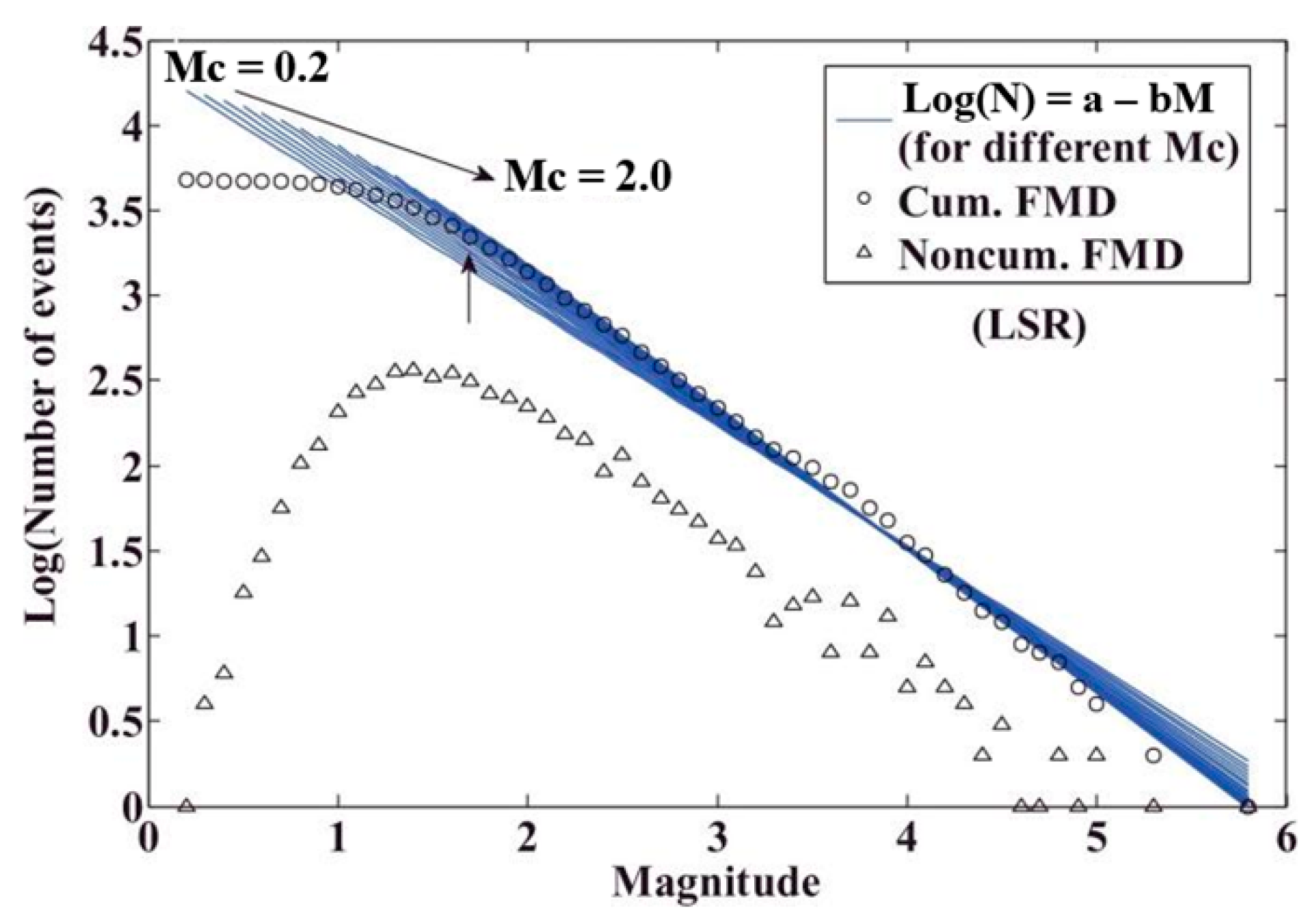

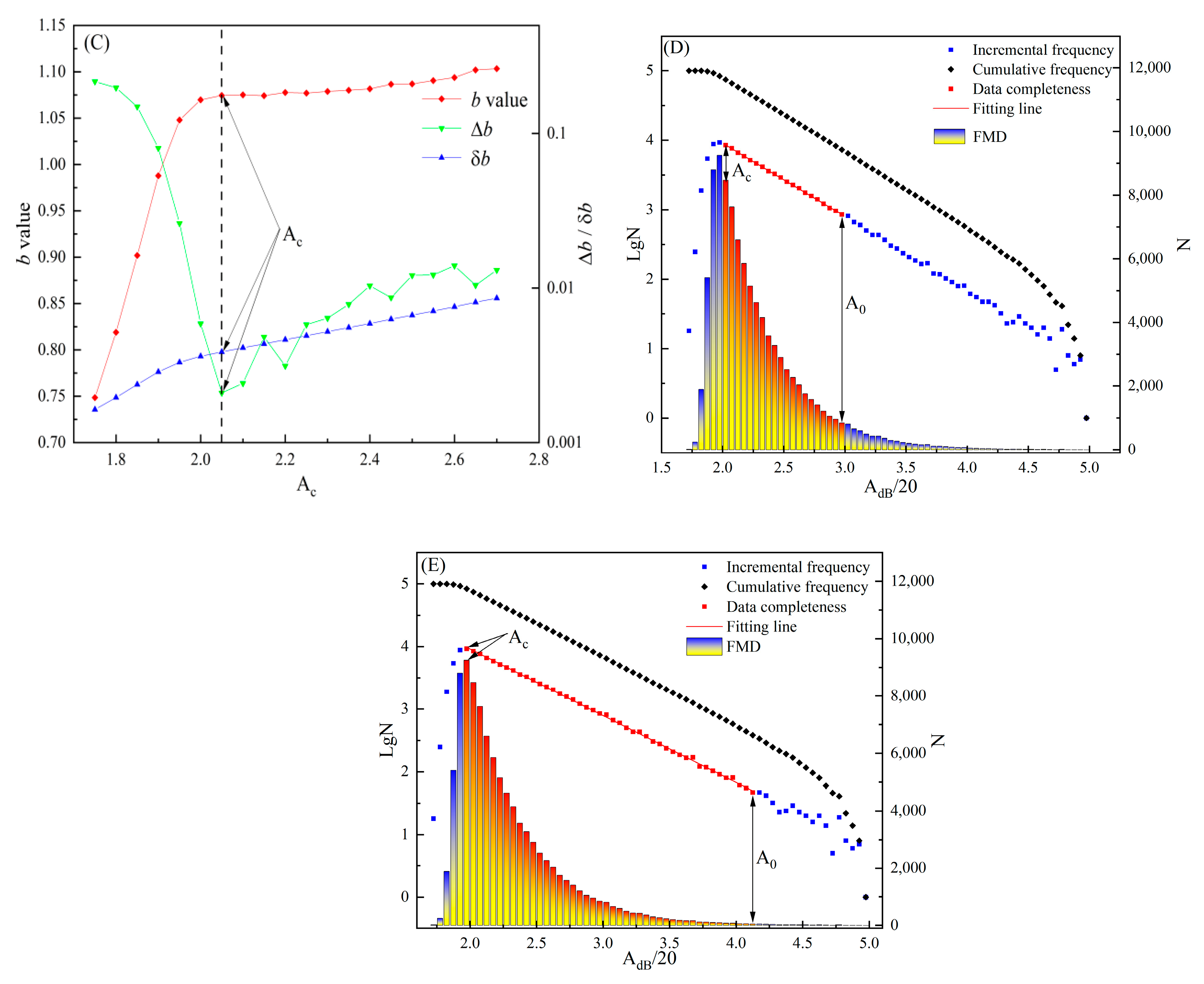


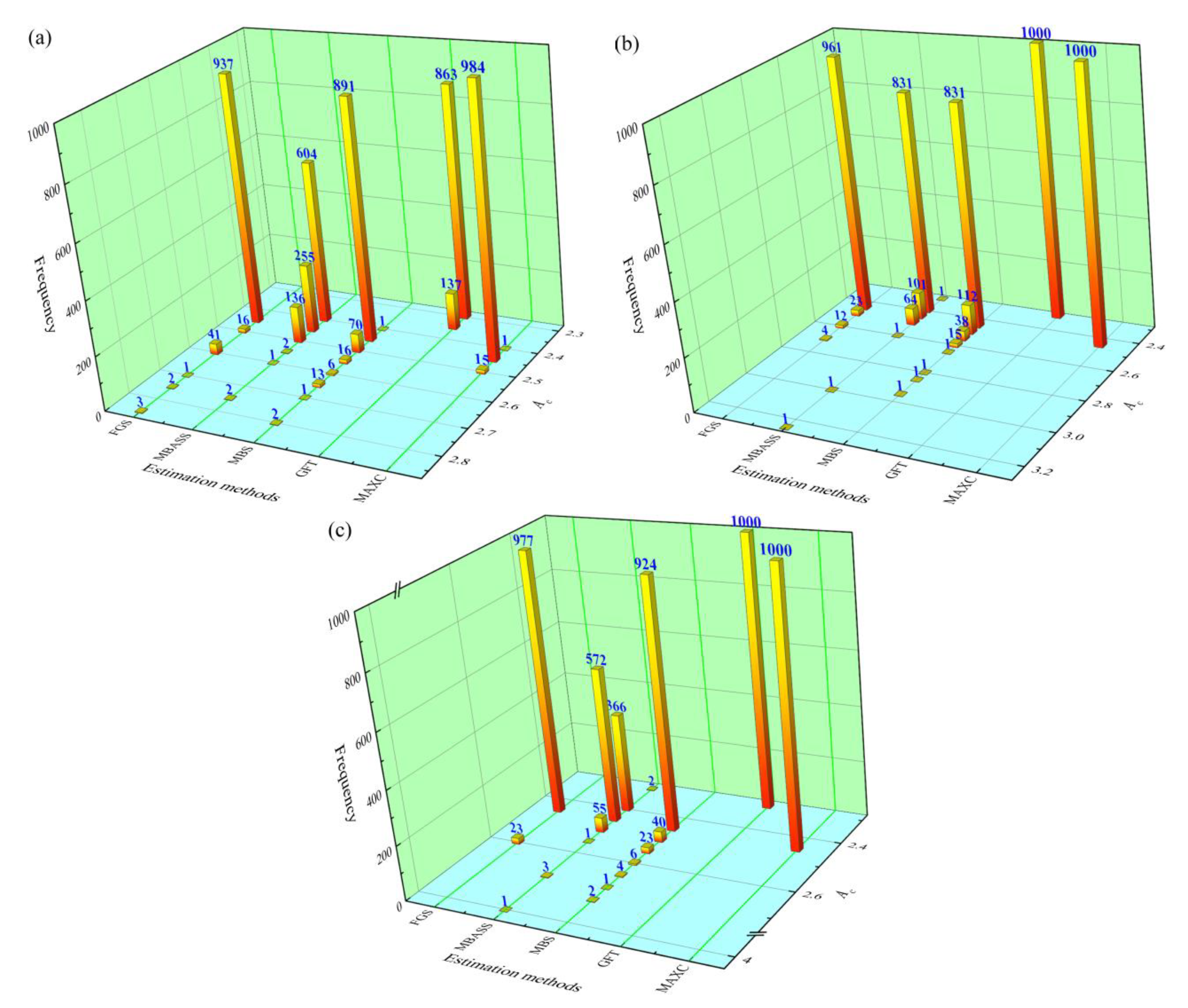
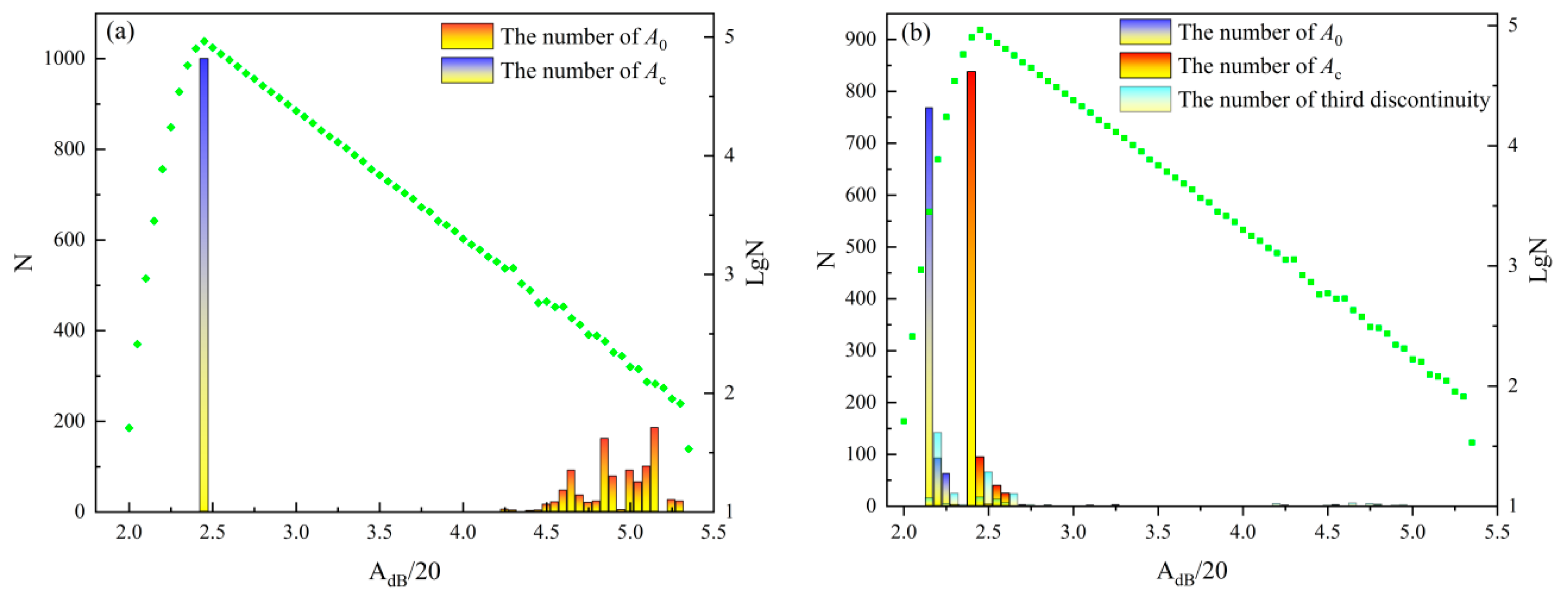
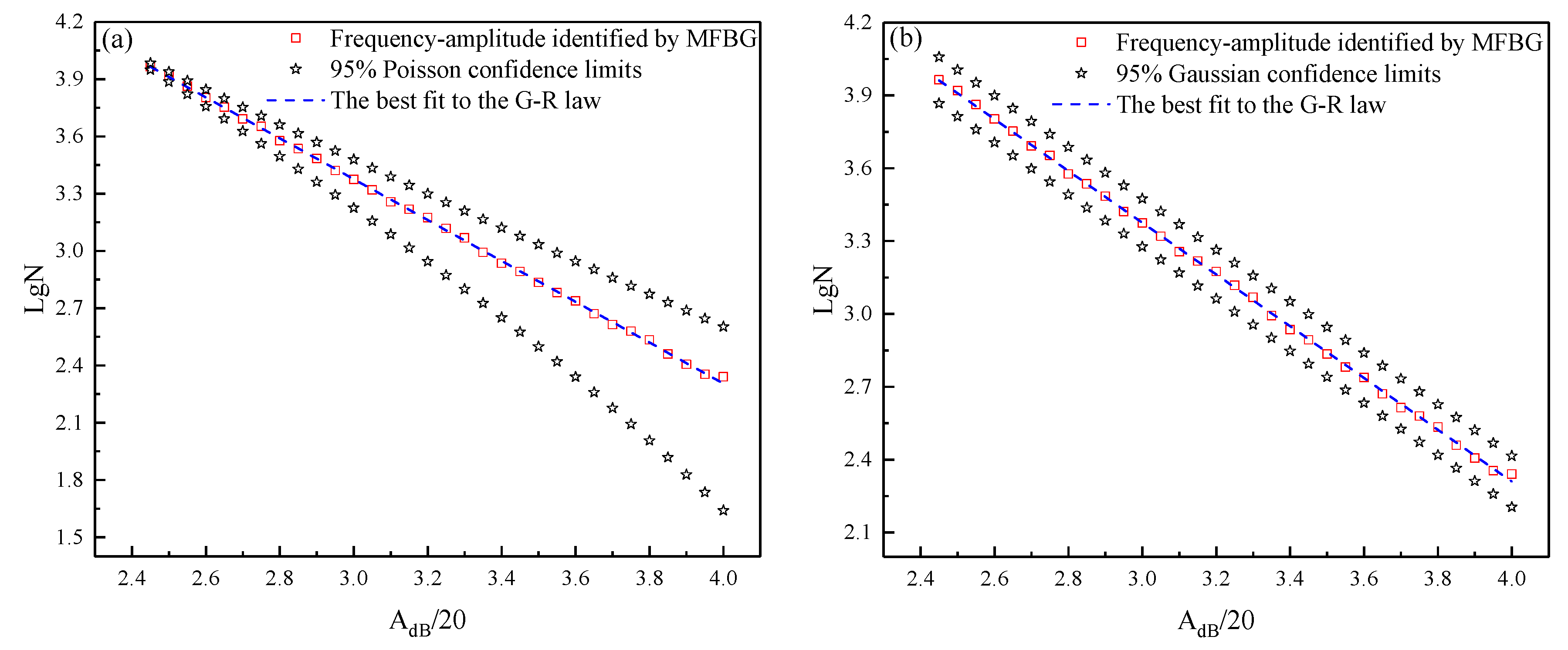
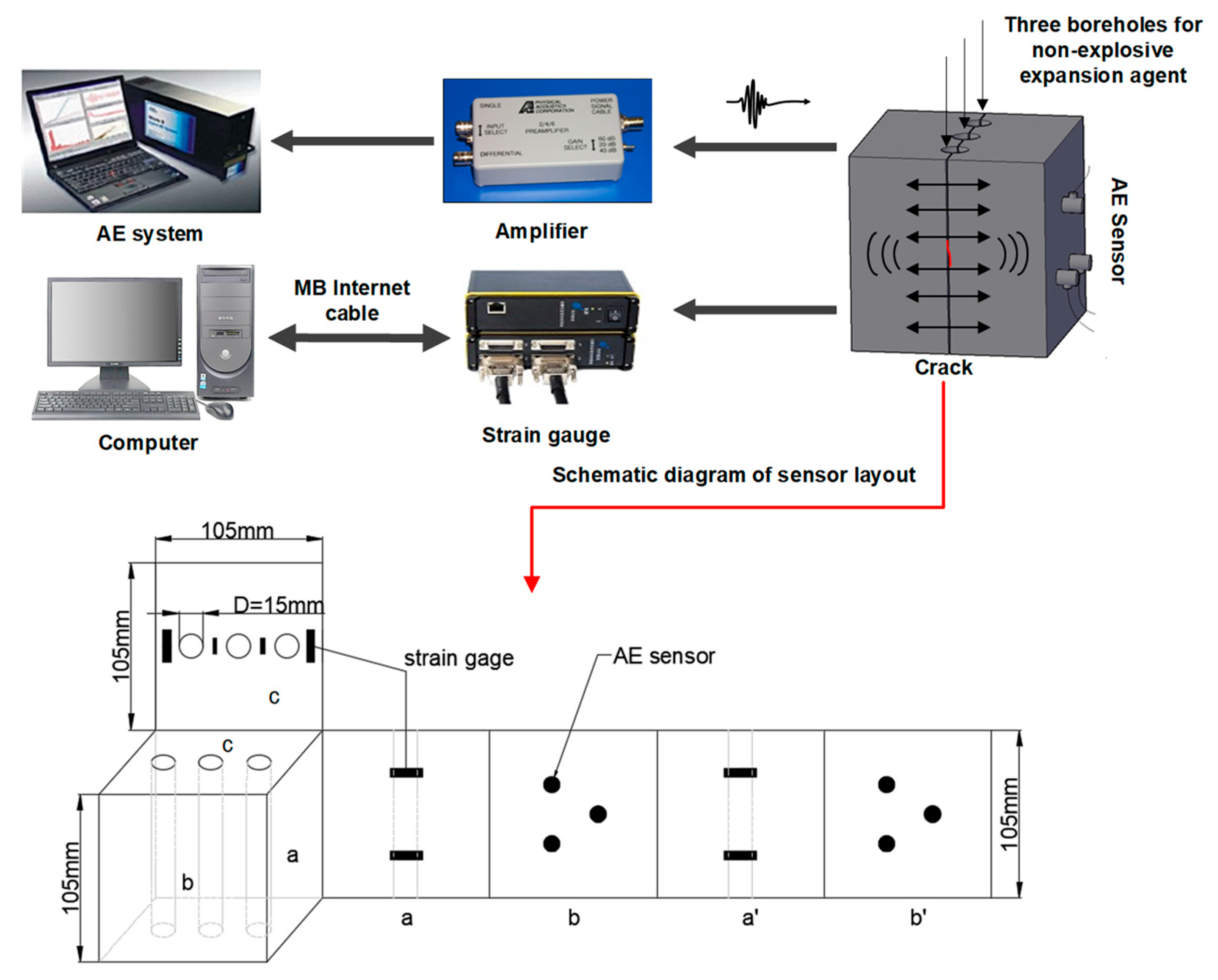

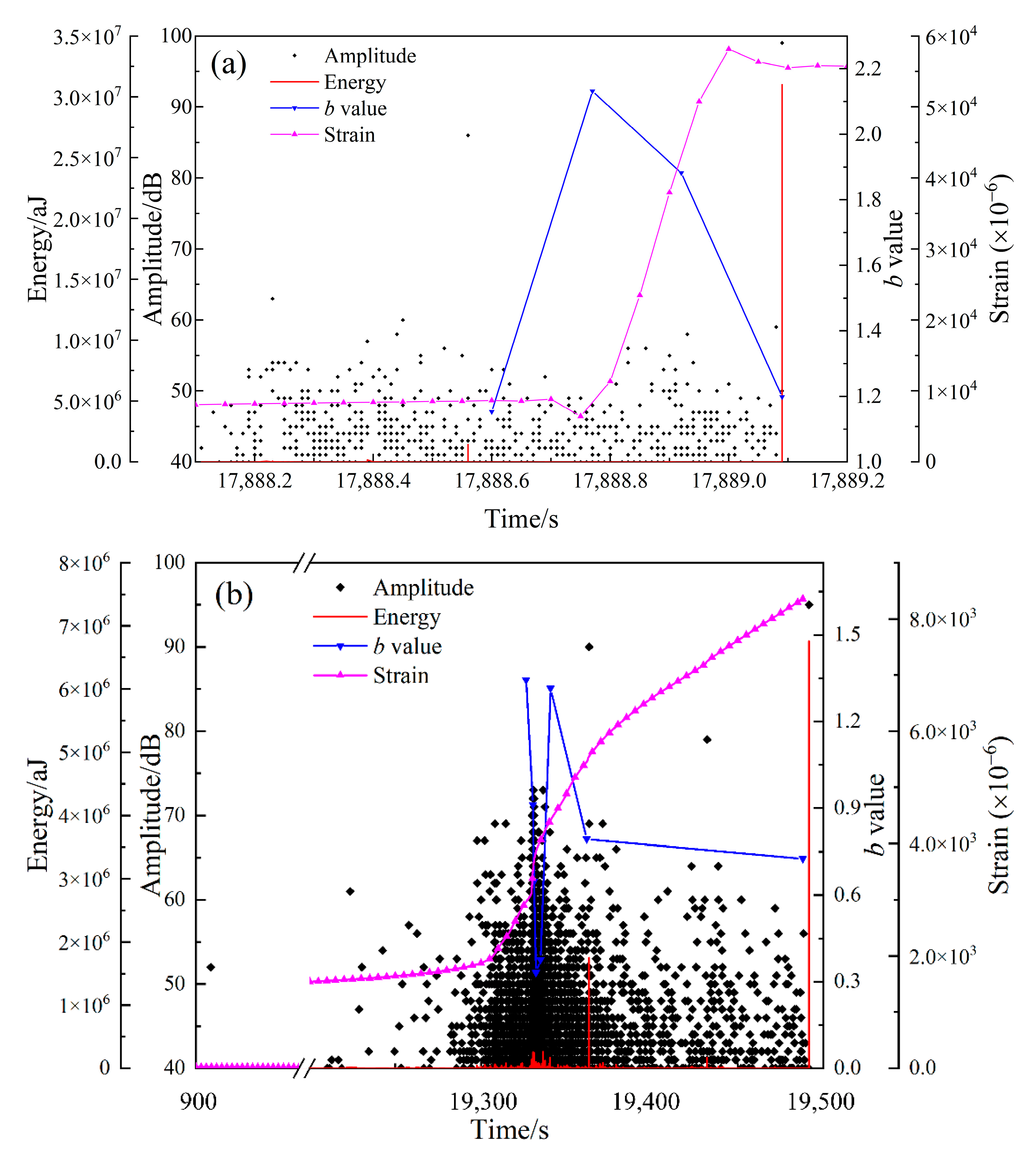
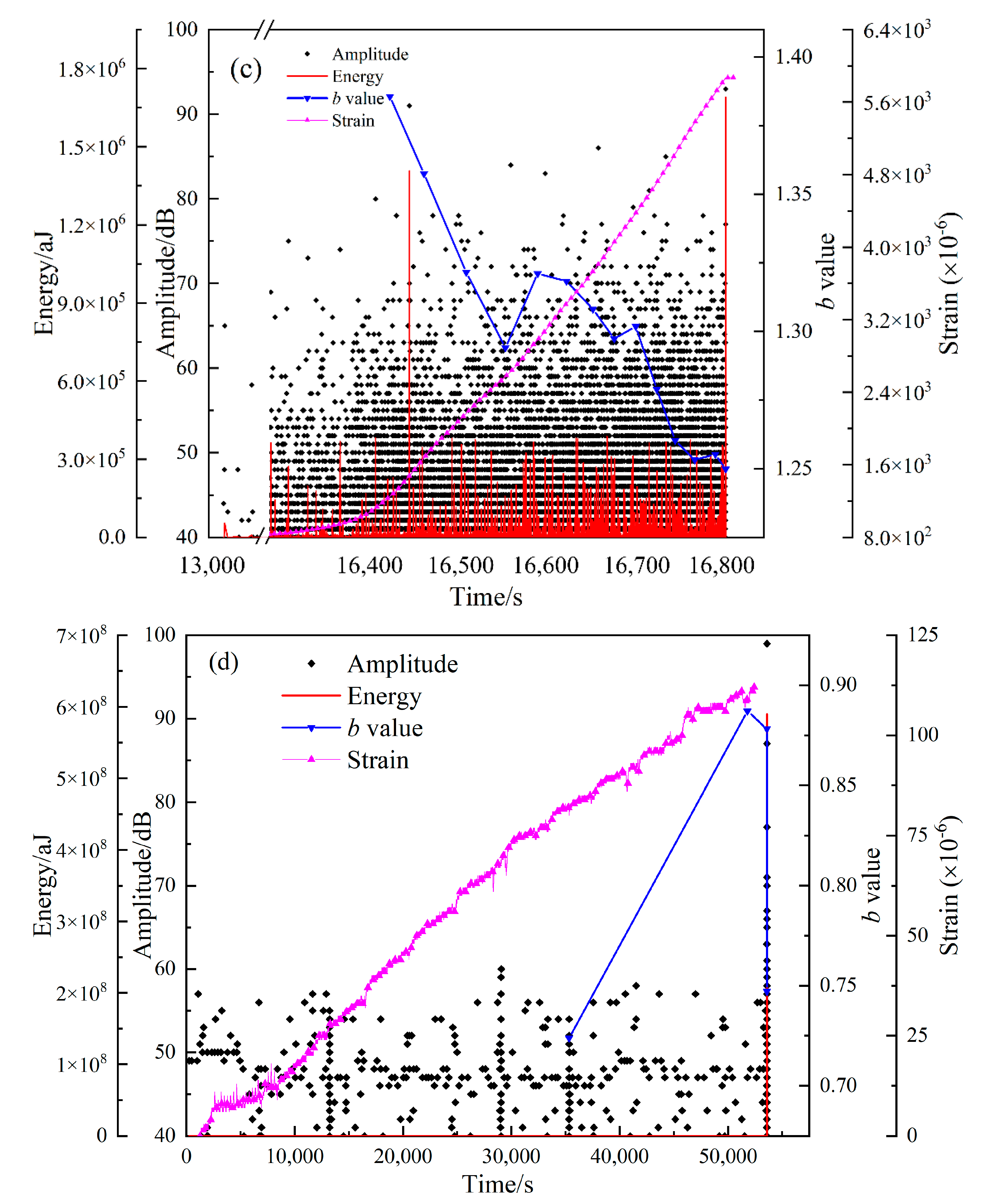
| Theoretical b Value | Estimating Method | Estimated b Value | Standard Deviation | Bias |
|---|---|---|---|---|
| 1.0666 | GLM | 1.0705 | 0.0471 | 0.0039 |
| LSR | 1.0714 | 0.0039 | 0.0048 | |
| MLE | 1.0711 | 0.0233 | 0.0045 |
| Sampling Rate/MSPS | Resonant Frequency of Sensor/KHz | Threshold/dB | PDT/μs | HLT/μs | HDT/μs |
|---|---|---|---|---|---|
| 10 | 140 | 40 | 50 | 300 | 200 |
| Channels | Mean b Value | |||
|---|---|---|---|---|
| Red Sandstone | Marble | Granite | Limestone | |
| 1 | 1.1009 | 0.8202 | 0.71992 | 0.40395 |
| 2 | 1.14325 | 1.0878 | 0.74096 | 0.55178 |
| 3 | 1.1957 | 1.10356 | 0.80763 | 0.59163 |
| 4 | 1.29028 | 1.15292 | 0.98828 | 0.63416 |
| 5 | 1.46777 | 1.2006 | 0.99417 | 0.75007 |
| 6 | 1.8879 | 1.2024 | 1.00422 | 0.82052 |
Publisher’s Note: MDPI stays neutral with regard to jurisdictional claims in published maps and institutional affiliations. |
© 2022 by the authors. Licensee MDPI, Basel, Switzerland. This article is an open access article distributed under the terms and conditions of the Creative Commons Attribution (CC BY) license (https://creativecommons.org/licenses/by/4.0/).
Share and Cite
Chen, D.; Xia, C.; Liu, H.; Liu, X.; Du, K. Research on b Value Estimation Based on Apparent Amplitude-Frequency Distribution in Rock Acoustic Emission Tests. Mathematics 2022, 10, 3202. https://doi.org/10.3390/math10173202
Chen D, Xia C, Liu H, Liu X, Du K. Research on b Value Estimation Based on Apparent Amplitude-Frequency Distribution in Rock Acoustic Emission Tests. Mathematics. 2022; 10(17):3202. https://doi.org/10.3390/math10173202
Chicago/Turabian StyleChen, Daolong, Changgen Xia, Huini Liu, Xiling Liu, and Kun Du. 2022. "Research on b Value Estimation Based on Apparent Amplitude-Frequency Distribution in Rock Acoustic Emission Tests" Mathematics 10, no. 17: 3202. https://doi.org/10.3390/math10173202
APA StyleChen, D., Xia, C., Liu, H., Liu, X., & Du, K. (2022). Research on b Value Estimation Based on Apparent Amplitude-Frequency Distribution in Rock Acoustic Emission Tests. Mathematics, 10(17), 3202. https://doi.org/10.3390/math10173202







